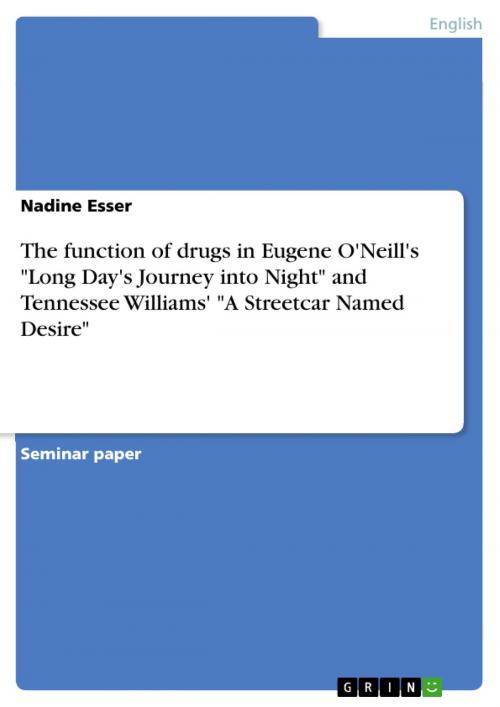The function of drugs in Eugene O'Neill's 'Long Day's Journey into Night' and Tennessee Williams' 'A Streetcar Named Desire'
Nonfiction, Entertainment, Drama, Anthologies| Author: | Nadine Esser | ISBN: | 9783638898003 |
| Publisher: | GRIN Publishing | Publication: | November 13, 2007 |
| Imprint: | GRIN Publishing | Language: | English |
| Author: | Nadine Esser |
| ISBN: | 9783638898003 |
| Publisher: | GRIN Publishing |
| Publication: | November 13, 2007 |
| Imprint: | GRIN Publishing |
| Language: | English |
Seminar paper from the year 2007 in the subject American Studies - Literature, grade: 2,3, RWTH Aachen University (Institut für Anglistik), course: Modern American Drama, 9 entries in the bibliography, language: English, abstract: The two plays Long Day's Journey into Night by Eugene O'Neill and A Streetcar Named Desire by Tennessee Williams can be seen as two of the most successful and respected plays of American Modernism. Besides other similarities, both plays deal, more or less obviously with the consumption of alcohol and - in case of Mary Tyrone in Long Day's Journey into Night - drugs. This paper's matter is to find out what function drinking or the consumption of other drugs have for the characters of the two plays. This question could also be interesting looking at the authors: O'Neill's play has very many parallels to his own life and also Williams admitted that he is to be found in the character of Blanche DuBois to a certain extend.
Seminar paper from the year 2007 in the subject American Studies - Literature, grade: 2,3, RWTH Aachen University (Institut für Anglistik), course: Modern American Drama, 9 entries in the bibliography, language: English, abstract: The two plays Long Day's Journey into Night by Eugene O'Neill and A Streetcar Named Desire by Tennessee Williams can be seen as two of the most successful and respected plays of American Modernism. Besides other similarities, both plays deal, more or less obviously with the consumption of alcohol and - in case of Mary Tyrone in Long Day's Journey into Night - drugs. This paper's matter is to find out what function drinking or the consumption of other drugs have for the characters of the two plays. This question could also be interesting looking at the authors: O'Neill's play has very many parallels to his own life and also Williams admitted that he is to be found in the character of Blanche DuBois to a certain extend.















